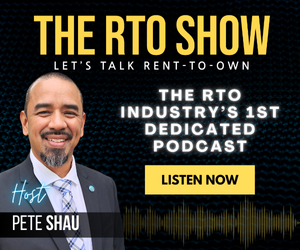Whether you’re hiring, training, engaging, bonding, or praising, the secret sauce of better bossing is just this: Take time with your people
When we say ‘post-pandy’ (post-pandemic) era, it’s really just a new era,” notes Pete Shau, a District Manager with CPL Group Inc., dba Rent King. “We have to get used to the way things are now, because it’s not going to go back to the way it was. This is a new era, and it’s the way things will be moving forward.”
Shau, along with fellow Rent King District Manager Danny Lastra, presented their insights into what leadership looks like today in Managing in a Post-Pandy World, a popular education session at this year’s RTO World. They began with the core leadership skills they believe are needed to manage in this new era.
“Rent-to-own is a profound and dynamic business,” says Shau. “Changing market conditions and technologies means organizations need to assess their current situation, analyze the competitive environment, set goals and objectives, and formulate strategies based on resources. Implementing those strategies and measuring their effectiveness is the key to success.”
OK, Shau read that off of his PowerPoint deck. But he and Lastra then took dynamic turns offering five things each that they think managers should be doing today to improve their team relationships and results. And interestingly, many of the duo’s recommendations revolve around a singular concept: Taking time.
Shau’s Supervisory Suggestions
1. Ensure that your store’s next-inline leadership is ready to take the reins.
“We must begin showing younger folks how to get stuff done,” Shau begins. “If we don’t start doing that, then we’re setting them up for failure, and they will fail. And when they fail, they will leave. And when someone leaves, we have to spend time, money, and energy searching for someone new.”
Shau urges managers to spend time training rising stars before promoting them – don’t assume they will automatically understand the new role they’ll be playing.
“Your stores are one-hundred percent important enough to wait for the right person, train them thoroughly, and make sure they’re ready for the position,” stresses Shau. “Don’t fill a hole in your team with someone who isn’t right or isn’t ready – it won’t work.”
According to Forbes, when managers invest in the development of their employees and their skills, they see an increase in employee satisfaction, better team performance, and higher engagement levels.
“Take the time and you’ll see a big difference,” Shau says. “Spend time finding a good fit and making sure they understand their new position completely. Take your people by the hand and lead together. They want that and they need it.”
2. Cultivate more collaboration on goal-setting and difficult tasks.
“We hold our people accountable for accomplishments, but we don’t get their input on it,” notices Shau. “We don’t give them a chance to tell us how they might tackle a project or solve a problem, or whether our expectations are realistic.”
According to Shau, satisfied employees can have a positive impact on company performance – and including them in problem-solving helps nurture a team environment, and make members more invested in achieving the goals they helped create.
“Gather your people, sit down with them, and say, ‘Let’s set some goals,’ Shau directs. “Explain to them exactly what you want to do and get their feedback. ‘How will you achieve this? This is what I expect; can you do that?’ Then provide them with the training, resources, and fortitude necessary for them to achieve what you’ve agreed to together.”
3. Foster respect by forging connections with your people.
“A McKinsey & Company study showed that 75% of American workers viewed their manager or boss as the most stressful part of their job,” quoted Shau. “Unacceptable! We care about our employees – they’re going to get us to the next level, and we won’t get there without them. I can sell. I can deliver. I can manage. But I can’t do it alone, and neither can you. We have to show our team members how much we care about them.”
Shau also noted referenced polls saying 40% of employees stay at their jobs because of the social relationships they create at work – even if they dislike their current job.
“A team environment is essential,” echoes Shau. “If your people like you and you share an authentic bond, they’ll likely stay with you even though it’s hard work – and they’ll work harder for you while they’re there.”
4. Use reinforcement mechanisms – early and often.
“Establish a process in which positive reinforcement happens on a regular basis,” Shau instructs. “Give your employees something they can wear – a pin or a special shirt – to recognize them for learning something new, achieving the goals you set together, hitting a quota. Give them something they can wear every day, not put on a wall.”
Praise and promote your people as much as you can, continues Shau. Be specific about the behavior you want to reinforce; explain why it’s important; tell them how good they’ve made you feel and how you look forward to seeing it happen again.
“When you’re acknowledging your team members, let them bask in it for a bit,” Shau affirms. “Take time to let them feel good in your presence – not on your way out the door, not as an afterthought. Give them your time to let them know just how special they are.”
5. Being a good boss isn’t easy; you’ve got to work on your own self, too.
“According to a Gallup survey out of MIT, only 10% of people in this business naturally have the characteristics of a great manager – they’re natural-born leaders,” says Shau. “The rest of us have to work to acquire and develop these traits. We’re learning just like everybody else – learning how to be a better manager, how to take care of people, how to do more with what we’ve got.”
Shau and Lastra both encouraged managers to read more, specifically recommending The One-Minute Manager by Drs. Ken Blanchard and Spencer Johnson, and How to Win Friends and Influence People by Dale Carnegie. The pair also took the Dale Carnegie Course for Business Leaders and recommend it heartily.
“Engage with your people every day,” Shau concludes. “Be part of what’s happening day to day, talk with your team, empower them to make the decisions you’ve taught them to take on. And connect with other RTO managers – both in your company and in others – to share tips, solutions, and ideas. We can all learn from each other, and together, be better.”
Lastra’s Leadership Laws
1. Don’t criticize or complain.
“Don’t criticize your people,” Lastra begins. “Because if you’d lived their life, grew up how they grew up, then you’d probably believe what they believe, behave how they behave. We’re always telling our account managers, ‘Don’t be so hard on customers, try to understand where they’re coming from, what their hardships are.’ Do we practice the same philosophy with our team members?
When someone’s late, when they call out, when they’re having car issues – are we trying to understand where they’re coming from?”
2. Give honest, sincere appreciation.
“People don’t work for a company, they work for other people,” says Lastra. “I work for my bosses, and my team works for me. They call me, they cry to me, they vent to me. It’s the same with your employees – they work for you. You’re the person they look up to, you’re the person they want to make proud, and you’re the person who must provide them with praise and gratitude for a job well-done.
“In this new era, employees – especially Millennials – need positive reinforcement, and they need it daily,” he continues. “When they do some little thing correctly, you’ve got to make a big deal of it. When we watch our team members growing and learning and developing, we ought act like proud parents – let them catch you beaming a bit.”
3. Show them they’re important.
According to psychologist and philosopher John Dewey, The deepest need in human nature is the desire to be important – the need to be seen, heard, and paid attention. Which is why Lastra attests that when it comes to praising your people, a gift card or a free lunch isn’t enough.
“I talked with someone recently who, once an employee has been on-board for two weeks, he takes their whole family out to a nice dinner,” affirms Lastra. “He meets the employee’s spouse and children, gets a glimpse of their nonwork life. Now that’s personal. That’s more than just ‘Good job, Dude. Thanks.’ That’s I want to get to know you. I value you. You’re important.”
4. Let go of expectations.
Managers tend to focus on the employees who shine brightest – the rising stars, the go-getters, the ambitious. But not everyone is meant to be a leader. Some folks are content to be “worker bees,” the doers – and they’re exceptional at it.
“There’s nothing wrong with the doers,” Lastra agrees. “Acknowledge the doers and keep them happy, because every team needs them in order to succeed. We all have flaws – nobody’s perfect. You accept the good with the not-as-good in everyone, and you work to enhance their strengths and slowly try to improve their weaknesses.
“When our employees are failing, it’s because we’re failing them,” he continues. “We’re not doing what it takes to properly train or support them. You’ve got to engage them in conversation about how things work and how things are working for them. Have a real, true open-door policy. You can’t be afraid of criticism, and they can’t be afraid to offer it.
5. Attitude reflects leadership.
Employees feel their boss’ energy. They know when their manager is having a bad day. They can tell when their supervisor is upset or angry. Which is why Lastra feels if managers want to motivate their people, then they must learn how to check their troubles at the store door.
“Even a nonchalant, go-with-the-flow kind of manager won’t inspire people to action and improvement,” he says. “Your team is reading your energy, they’re picking up on what you’re putting down. So you have to come into work pumped up and SMILING. You’ve got to come in with a positive, take-charge attitude – We’re the best! We’re going to have a great day! We’re going to kick ass, we’re going to take names! We’re going to close every sale! And we’re going to high five!”
Kristen Card has been a contributing writer for RTOHQ: The Magazine for more than 15 years.









